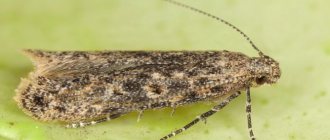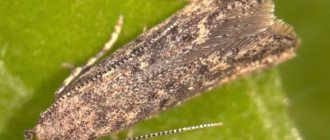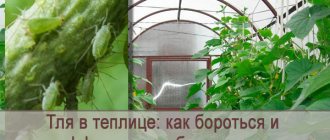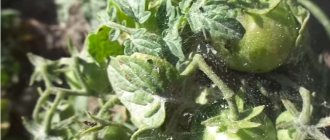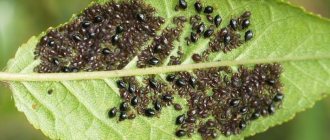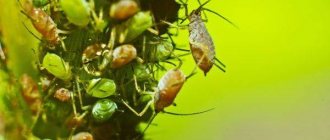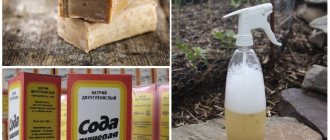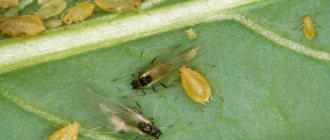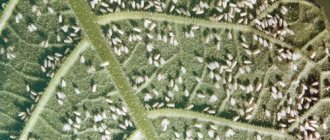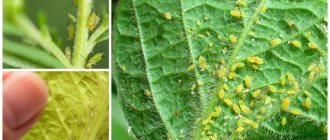The melon aphid affects many agricultural crops, in particular tomatoes. Settling on the underside of the leaves, the insect sucks out all the juices from the young leaves, as a result of which the plant dies.
Once on a tomato bush, aphids quickly spread throughout the entire garden bed, giving neither young nor mature tomatoes a chance to survive.
Life cycle and description of melon aphid
The life cycle varies greatly between the northern and southern regions.
In the north, female nymphs hatch from eggs on primary hosts in the spring. They can feed, mature and reproduce parthenogenetically (viviparous) on one host all summer, or produce winged females that disperse to secondary hosts and form new colonies. Dispersers tend to select new growth to feed on and can produce either winged (alata) or wingless (aperthese) female offspring. Under conditions of high density, when the host plant is wilting or in autumn, the production of winged forms predominates. At the end of the season, the winged females seek out primary hosts and eventually both males and females are born and lay eggs. They mate and the females lay yellow eggs. Eggs are the only hibernating form in cold conditions. In warm conditions, a generation can be completed in about seven days. In the south, gender forms are not important. Females continue to produce offspring without mating as long as the weather allows them to feed and grow. Unlike many species of aphids, hot weather does not have a negative effect on melon aphids. Melon aphids can complete their development and reproduce in as little as a week, so that multiple generations are possible under suitable environmental conditions.
The eggs are laid yellow, but soon turn shiny black. As noted earlier, eggs are usually laid on catalpa and rose of Sharon.
Nymphs vary in color from brown to gray or green, and are often marked by a dark head. The thorax, wing pads and distal part of the abdomen are dark green. The body is dull in color and covered with waxy secretions. The nymphal period averages about seven days.
Aphids go through four molting stages before they reach maturity. At each stage they lose their white skin. Cotton aphids are easily distinguished from other aphids due to the color of their two cores (siphuncles). These cores are always black, regardless of the color of the midge, which can range from light yellow to light green or even a green-black hue. This coloration depends on temperature, host plant and insect density.
Adult wingless (aparter) parthenogenetic females are 1 to 2 mm long. The body is quite variable in color: light green with patches of bright green is most common, but whitish, yellow, pale green and dark green forms are also found. The legs are pale with black paws. The folds are also black. The small yellow forms form in response to crowding or stress on the host plant. Winged (alate) parthenogenetic females range from 1.1 to 1.7 mm in length. The head and chest are black and the belly is yellowish-green, except for the tip of the belly, which is darker. The wing veins are brown. The oviparous female is dark purple-green; the male looks like the female. The duration of the reproductive period in an adult is about 15 days, and the post-reproductive period is five days. These values vary significantly, mainly depending on temperature. The optimal temperature for reproduction is from 21 to 27 degrees. Live females (give birth to live aphids) produce a total of 70 to 80 offspring at a rate of 4.3 per day.
Agrotechnical control measures
If this insect begins to actively develop on the site, then, most likely, treating the plants with chemicals or special decoctions cannot be avoided. You can also fight the annoying melon aphid using agrotechnical methods. They include the destruction of plants that contribute to the development of this pest, and the attraction of the most dangerous enemies from the insect world. At the beginning of the article it was mentioned that initially aphids lead an active life on garden weeds, so you should regularly weed the beds to remove unwanted guests.
You can also plant special plants on your site that will help you get rid of aphids. They can be scary or attractive. The former emit odors that this insect cannot tolerate, so it should be planted around protected garden crops. The latter, on the contrary, attract aphids, and they move onto them, leaving the vegetables alone. Such flowers and trees should be planted to the side. So, aphids cannot stand the smell of garlic, onions, fennel, coriander, basil, marigolds, mint, mustard, lavender and some types of chamomile. But petunia, beans, soporific poppy, mallow, viburnum, linden, bird cherry attract insects.
Some insects and birds are reliable helpers; they eat melon aphids that live on tomatoes or other garden crops. Ladybugs are one of the dangerous enemies, so you can even collect them in the fall and place them in a greenhouse. Hoverflies, earwigs, and some types of wasps are also capable of fighting effectively. By planting fragrant herbs in your garden, you will attract beneficial insects to your plot.
So that sparrows, kinglets, titmice, linnets, wrens and other birds that feed on green insects do not forget about you and not only delight you with their beautiful singing, but also actively fight small pests, you should build feeders and drinkers for them in winter. Only if you decide to fight aphids by attracting a living army of birds and insects, then do not use chemicals, as they are destructive to your allies.
Damage
Melon aphids feed on the undersides of leaves or on the growing tip of the vine, sucking nutrients from the plant. Foliage may become chlorotic and die prematurely. Their feeding also causes significant leaf distortion and curling, interfering with the plant's photosynthetic capacity. In addition, they produce large amounts of honeydew, which provides a substrate for the growth of sooty mold, so the quality of the fruit may be impaired and the photosynthetic capacity of the foliage further hampered.
Melon aphids are effective at transmitting viruses, although they are only one of dozens of species involved in the spread of plant viruses in cucurbits. Cucumber mosaic virus, watermelon mosaic virus, and zucchini yellow mosaic virus are transmitted by these aphids despite the use of insecticides and oil sprays, probably because the viruses can be transmitted within 15 seconds.
Signs of aphids on tomatoes
Aphids enter tomato plantings in different ways: through weeds, purchased seedlings, soil, and insects. With the onset of warm weather, females begin to reproduce, forming a large colony.
Melon is located on the underside of leaves growing on young stems and shoots. Symptoms of aphids on tomatoes:
- curling, drying out of young foliage;
- a sticky whitish coating appears on the shoots - waste products of the pest;
- the tomato bush stops growing;
- There are a lot of ants in the garden bed.
If you examine the leaf blade, you will notice a dark teeming mass - this is a rapidly reproducing aphid. By sucking plant juices, it disrupts the process of photosynthesis in plants. But besides this, aphids poison the plant with toxins. Because of this, the plant cannot consume nitrogen in proper quantities. The tomato bush becomes weak and vulnerable. Leaves and shoots become deformed, dry out, fruits become small and clumsy. Their taste spoils.
Insecticides
If insecticides are used to control melon aphids, care should be taken to thoroughly cover the foliage of the plant. Leaf distortion caused by aphid feeding provides excellent cover for insects, so systemic insecticides are useful. Early in the season, aphid infestations are often localized, and if such plants or areas are treated promptly, much damage can be prevented this season. Using insecticides on other, more harmful insects sometimes results in melon aphid outbreaks. However, melon aphid resistance to chlorinated hydrocarbons, organophosphates, and pyrethroid insecticides is widespread.
Prevention measures
You can avoid the appearance of insects on tomatoes by applying timely protective measures.
Seasonal preventive manipulations:
- In the fall, after harvesting, it is necessary to thoroughly clear the ground of plants in which pests are hiding. The soil needs to be dug deep - this way you can destroy the egg laying in the soil spores;
- In the spring, before planting seedlings in the garden, the ground must be treated with insecticides such as Karbofos (60 grams per bucket of water). Moreover, the frame and walls of the greenhouse are disinfected - all surfaces are washed with a manganese solution or treated with copper sulfate.
- Along the tomato beds, along with the seedlings, fragrant plants are planted that repel insects - marigolds, lupine, dandelion, wormwood, dill, celery.
- Anthills found on the site must be moved outside the site.
- Tomato bushes should be regularly inspected for pests. If lesions are found, it is better to remove them from the plant.
By the way! Aphids are attracted to plants such as viburnum, nastrutia, cosmos, begonia, poppy, linden, and mallow. Therefore, tomato beds should not be placed next to these bushes.
Plant protection from pests
In the spring, with the appearance of cotyledon leaves, aphids begin to colonize the plants, which are especially harmful in the early stages of growth of melon crops. Cutworms and ants cause considerable damage during this period. In irrigated areas or in wet years, wireworm larvae also cause significant damage, damaging seeds and even ripening fruits. Preparations of the diazinon group have good effectiveness against this complex of pests. In later periods of the growing season, it is recommended to use insecticides with the active substance thiamethoxam, lambda-cyhalothrin or imidacloprid, belonging to the 3rd and 4th hazard classes with a short waiting period, or biological remedies Fitoverm, Fitomectin, Biostop, etc.
Low temperature protection
In the Krasnodar Territory, early shoots are often exposed to low temperatures and even frosts, which are possible until the end of the first ten days of May. Low temperatures cause plant paralysis or death. In order to smooth out the impact of these unfavorable factors on germinating seeds and plants, it is necessary to use cryoprotectors.
Soaking seeds or treating plants a day before the expected temperature drop below the biological minimum with Epin at recommended standards ensures plant protection for 2 weeks. If necessary, spraying can be repeated.
Regularly inspect the lower leaves where the pest settles
| Features and reasons for appearance Description:
| |
| Symptoms ')); (w||(w=[]))&&w.push({id:b,block:'14502'});})(window,document,”mtzBlocks”); Description:
| |
| Basic methods of struggle Description:
| |
| Prevention Description:
|
List of watermelon varieties that best resist aphids
Gardeners, observing special growing conditions, choose varieties of watermelon seeds that are able to resist pests. If the soil of the earth is ready for planting and properly fertilized, then it is time to select seeds
It is worth paying attention to where the seeds came from, what packaging they are sold in, and whether the expiration dates are observed.
Below are the names of varieties and hybrids of watermelons that are better adapted to damage and pests.
| Name of variety/hybrid | Description/brief characteristics/resistance to aphids |
| Prince Hamlet F1 | Early ripening striped hybrid, fruit weight 1.5 kg. Suitable for growing in unfavorable climatic conditions, the flesh of the fruit is yellow, strong immunity to aphids. |
| HelenF1 | The hybrid is resistant to fusarium, anthracnose, and temperature changes. The fruit is striped, round, the fruit weighs 7 kg, the flesh is red. Stored for 2 months. |
| Start | Resistant to melon aphids and sudden temperature changes. It is a striped fruit with red flesh and weighs up to 5 kg. Shelf life 1 month. |
| Dolby F1 | Resistant to fusarium and anthracnose. 5 meter weaving plant, fruit weighing 9 kg and red pulp. Shelf life: 1.5 months |
| Trophy F1 | Early ripening hybrid, fruit weight 10 kg, resistant to fusarium. Technical ripeness is achieved in 65 days. |
| Crisby | Early ripening hybrid for fresh consumption. Resistant to fusarium. Fruit weight 6 kg. Technical ripeness occurs in 60 days. |
| Sugar baby | This variety can be grown in the northern regions. Fruit weight is 5 kg, suitable for autumn storage and resistant to fusarium and anthracnose. |
| SRD-2 | An early ripening fruit, weighing 7 kg, thick skin of dark green color, resistant to melon aphids and powdery mildew. |
| Krasen | Striped fruit weighing up to 8 kg. The pulp is sweet raspberry color. Resistant to aphids and anthracnose. |
Traditional methods
We should start with the fact that spraying even with special herbal decoctions and infusions can be dangerous. Highly concentrated solutions burn the leaves, some of them pose a danger to the beneficial inhabitants of the garden, and sometimes even to the human body. So before you give preference to one or another recipe, familiarize yourself with all the consequences.
To make a garlic infusion, mix 200 grams of the softened product in a liter of water and let it brew for 4 days. In this case, the container is tightly closed with a lid. To treat the plant, it is recommended to use 25 ml per ten-liter bucket of liquid. Gardeners also actively use a pepper-tobacco mixture. Take 30 g of hot pepper, finely chop it and add 200 g of tobacco dust to it, fill it all with water (10 l) and leave for a day. Before use, add half a glass of ash and a tablespoon of liquid soap. The consumption is approximately 1 liter per square meter; in severely affected areas the dose can be doubled. It is also recommended to repeat spraying after 7 days to achieve the effect.
Now let's talk a little about herbs. To obtain a decoction of celandine, make an infusion (400 g of green plant per 1 liter of water, leave for 24-36 hours) and boil it for half an hour. You can also take a kilogram of dry yarrow and pour two liters of clean water over the grass. After this, keep the resulting mixture in a water bath for 40 minutes and, having brought the volume of the decoction to 10 liters, leave it in a dark place for a couple of days.
There are also soap solutions. To prepare them, you should grate the soap and mix it with water in a certain proportion. If you use household water, then for 10 liters of water you will need 300 g of solid or 125 g of liquid product. Only 100 g of tar will be enough for the same volume of liquid. In addition, you can boil 200 grams of ash diluted in 10 liters of water for half an hour, and then add 40 grams of soap to it immediately before processing. All these methods have found wide application for the destruction of melon aphids that have settled on watermelons, cucumbers and other crops.
- Author: Mikhail Malofeev
Rate this article:
- 5
- 4
- 3
- 2
- 1
(6 votes, average: 3.3 out of 5)
Share with your friends!
